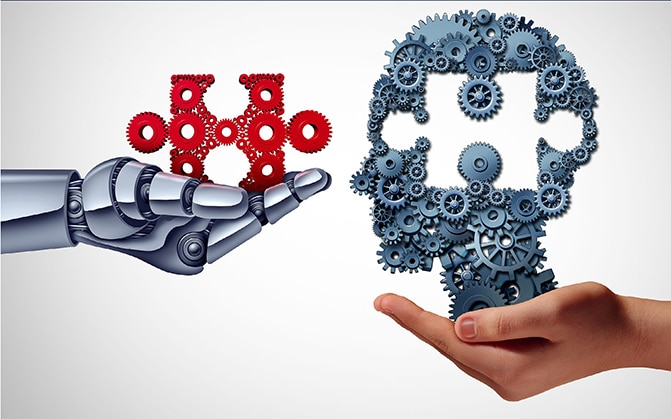
Automate and Educate: Streamlining School Processes with Automation
June 28, 2023
What One Tech Rabbi Thinks You Should Know About Educational Artificial Intelligence
June 28, 2023Rabbi Baruch Noy
Artificial Intelligence (AI) has been on the rise since science fiction media predicted its eventual creation. Since that fictional picture of what an artificially intelligent machine can accomplish, people have been attempting to build it. While AI has been in use among specific niche use cases and industries for a number of years already and has been embedded on devices such as cameras and smartphones, only recently has it become available to the greater public at no cost and with no specific hardware necessary other than an internet connection. GPT, a method of training the artificially intelligent computer system that is already on its fourth generation, just launched recently. There are a number of methods and platforms that are training artificially intelligent computer systems, but GPT became the most famous for having developed ChatGPT. ChatGPT harnesses the capabilities of the GPT method and platform of AI, and further allows people to interact with the AI platform through language-based prompts.
In truth, there are many different platforms that will produce different forms of media based on utilizing an AI platform. ChatGPT creates text output but does not (yet) create pictures or videos. Other AI-based platforms will take the same text-based prompts, but produce an image, video, or slideshow presentation based on the AI engine that it feeds from. Even mainstream tools that are not directly associated with AI have incorporated AI-based elements, such as Microsoft desktop products or Adobe Photoshop. By the time this article is published, Google will have also inserted AI-based creation elements into Google Docs and Google Slides. One can see very easily that AI has already affected certain business industries. The ability to produce text written in a professional style, graphics that can be based on famous works and automated lighting and color schemes, and videos showing engineered footage that can replace mistakes in filming, has already had an impact across professional industries, and will only continue to affect even more industries.
Plagiarism and Cheating When it comes to education, there is, understandably, a tremendous amount of hesitancy. So much of our focus as educators has been to teach students the skills that they need to produce original works, whether it be in writing, media, or mathematics, just to name a few subject areas. The “P” word has always been the clear red line that no student shall ever cross, for fear that their entire academic career, and likely their occupational career, will be forever derailed. At least it is in the minds of the educators. Meanwhile, it seems that students for around two decades already have never really had a good grasp of plagiarism, not its meaning, applications, or even consequences.
Donald L. McCabe was a professor at Rutger University in the Business School for 26 years. During that time, having transitioned into academia from the corporate world, he noticed a huge trend of students participating in activities that were certainly labeled as academically dishonest, but without too much hesitation. He began to study the issue of academic integrity and continued to do so for many years. During that time, he founded the International Center for Academic Integrity. Dr. McCabe passed away in 2016, and so he did not witness the AI revolution. However, he did witness the technology revolution of the early 2000’s, and how that impacted academic integrity.
In a paper from 2005 , McCabe wrote:
“In these Web surveys of over forty thousand undergraduates on sixty-eight campuses in the United States and Canada, conducted over the last two academic years, 21 percent of respondents have acknowledged at least one incident of serious test or exam cheating, and 51 percent have acknowledged at least one incident of serious cheating on written work. Although most had engaged in other cheating behaviors as well, four out of every five students who reported they had cheated on a written assignment acknowledged that they had engaged in some form of Internet-related cheating—either cut-and-paste plagiarism from Internet sources or submitting a paper downloaded or purchased from a term-paper mill or Web site.”
In that same year, McCabe had other findings related to high school students.
If those were his observations in 2005, one can imagine that those statistics continued to rise. Yet, there is no need to imagine. McCabe continued to produce alarming statistics for many years afterwards, all pointing to a single theme: Since the advent of computer technology in the home, students have become almost completely desensitized to using someone else’s original work.
On the flip side, McCabe produced a good amount of research showing that when schools clearly communicated the importance of producing one’s own content and the importance of true integrity, the actual numbers of students reporting academic dishonesty declined. In other words, just because it has become so commonplace for students to use the original work of others as their own, does not mean that we cannot contend with this phenomenon.
If you would ask educational leaders and classroom teachers how many of them communicate clearly to students about the technicalities of plagiarism, you would hear very few affirmative answers. If you would ask the same group how many of them stress the importance of original work that truly reflects their own thoughts and feelings or stress the importance of one’s integrity, you would receive even fewer affirmative answers. In our schools, we so often make assumptions about our students’ knowledge of, and attitude towards, plagiarism that do not align with reality. We suffice with having a policy in a handbook and the fact that these things are obvious. In reality, an overwhelming majority of our students are clueless about true academic integrity and possibly just true integrity. Our students are often defined as “digital natives”, or members of a certain generation denoted by a letter. One thing is for certain: they are members of the copy and paste generation, and it is habitual.
Based upon this background of the last two decades, AI tools that will create new content are even more unrecognizable as academic dishonesty. If the AI tool created the text, it is even less dishonest than copying and pasting for this text was never taken from any person. (In fact, institutions of higher education have amended their academic integrity policies to now say that a student’s work was not derived from someone or “something” else.) If anything, the more industry adopts these tools, the harder it will be to contend with any kind of dishonesty.
Education The main thrust of our response as an educational community has to be just that: education. Students need to understand the benefits and necessities of creating original content. Students need to understand the truths behind these AI tools. In particular, any AI tool that creates text, such as ChatGPT, has a human element behind the scenes that is currently directing the platform as to which responses are “more optimal” and which are “less optimal” (see Figure 1).

In other words, humans are directing the nature and content of the final product even if they are not producing the end result. As such, students need to ensure that any AI-produced text truly reflects their opinion and feelings on the subject matter at hand.
Similarly, any large-format writing assignment must have elements of opinion, hypothesis, and expression of feeling on the issues. These are the human elements that a survey of facts cannot produce. Some call it “higher-order thinking”, and others have other names for the concept, but this is a shift that must take place if it has not already. Once again, this is not a new adjustment; it is an important adjustment that has needed to take place since the dawn of the information age and the internet highway. However, it is pressing now more than ever.
As many others have pointed out, it might also be wise to shift assessments and writing assignments to live-action presentations or other forms of media production that are not scripted by AI. While this strategy might be correct, it does not detract from our educational mandate to help students understand the fundamentals of originally produced work and academic integrity. If we only shift assessments to alternate forms of assessment and do not tackle these important issues educationally, we will have done a disservice to our students.
Using AI to Improve Education On the flip side, use of AI tools like ChatGPT could allow students access to high-level sample work. Given the proper guidance, students that are weak at specific elements of writing can learn how to produce work of a higher quality and focus on the specific elements that they have trouble with. For example, if a student has written four paragraphs of a five-paragraph essay, but struggles with well-written conclusion paragraphs, they can feed their existing four paragraphs into the tool and prompt the tool to write a conclusion paragraph. Once generated, the student can see a very specific example of a high-level conclusion paragraph upon which they can base their own originally created conclusion paragraph. If used as a resource for style and language and to target specific elements of weakness, such AI tools can be invaluable.
Another area that could gain from AI tools, and could apply to the Judaic studies classroom as well, is graphic images created through AI. Whether utilized by the teacher with students’ input or utilized by students themselves, one can enter a prompt and produce a realistic simulative image for instances where we have no such graphic documentation. This is especially true when learning chumash or navi where it is challenging for students that are typically consumers of content to imagine on their own what it may have looked like. For example, Figure 2 is an image produced with a prompt that briefly describes the Jews going into the sea before it split. The image clearly conveys graphically the amazing sense of dedication and faith that they must have had.



Images produced using Midjour-ney, an AI tool that produces images based on prompts
Another image, Figure 3, could be a realistic image of Eliyahu Hanavi on top of Har HaCarmel, speaking to the people below. Figure 4 might be the moment where he looks up in prayer and says “Aneini Hashem aneini”.
While it is extremely important to preface that all of these images are fictitious and do not necessarily reflect the person, place, or event, it is also extremely helpful to have some method of creating a realistic picture of the awesome nature of the event. In fact, using AI to create the image and being able to refine the image using the prompts is far superior to any graphic that was created by someone ignorant of the details of the event or person. The teacher or student can include authentic elements of the event that reflect the true details of the event, all by using an authentic prompt with detailed information that they gleaned from the text. Another major benefit of using the AI tool in a guided environment is that the student is being introduced to the tool in the context of an authentic use case and is being taught how to be constructive with technology tools.
[A note of caution: These examples are by no means an endorsement of any platform to use in the classroom. Every new technology and platform must be vetted to ensure that it is safe and in compliance with educational laws, as well as the hashkafa of the school.]
The challenges of producing original, creative work in the era of freely accessible AI tools are serious. At the same time, there are likely to be some benefits that can be reaped by our schools and students towards making their learning more authentic and successful.
Rabbi Baruch Noy serves as a high school principal in the Five Towns and directs JEDIT for CoJDS. He works with schools across the continent in all areas related to IT and EdTech and previously served as Director of STEM Education, IT, and EdTech at HAFTR. He has a master’s degree in education focusing on Curriculum and Instruction and is currently a doctoral student in Educational Leadership. Having been a classroom teacher of Judaics and General Studies, as well as an administrator across many capacities, he is able to work with schools to help them upgrade in many areas.

